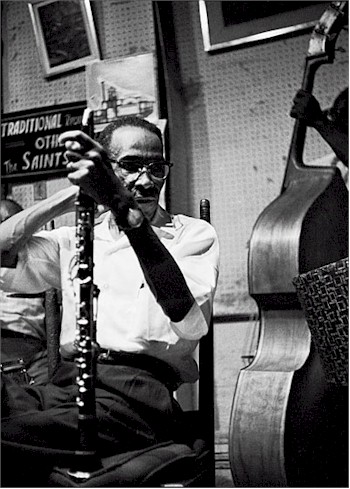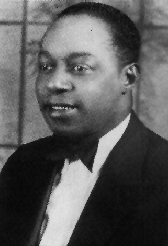
George Lewis, composer of "Burgundy Street Blues." Preservation Hall 1966. Photo © John Spragens, Jr. Courtesy of All That.
Take a tour of New Orleans musical geography, from the early 1900s through the 1920s, when the Crescent City was one of the hottest music cities in America.
In the 19th century, New Orleans was a huge shipping port, built on trade around the world. The city was a mix of French, African and Spanish with large Irish and Italian communities. This cultural mix made for a vibrant melting pot of rhythm and melody that added fuel to the sound of early jazz.
By the turn of the 20th century, New Orleans was a wide open city, and favorite pastimes were gambling, horseracing and playing music. The streets of old New Orleans were built along the curves of the Mississippi River, rather than according to a compass. Common directions refer to Uptown, meaning 'up river,' or Downtown, indicating 'down river.'
The French Quarter is 'Downtown' where street names are familiar from the titles of well-known classic jazz tunes: Canal St., Basin St., Rampart St., Burgundy St., Bourbon St. and Bienville Ave.. Back in the day, the French Opera House was on Bourbon St. and Jelly Roll Morton loved to go there to listen to operas like Bizet's Carmen from which he took inspiration for his jazz compositions.
New Orleans native Vernel Bagneris brings the voices of old New Orleans alive through first person accounts of early jazz musicians—trombonist Kid Ory, pianist Jelly Roll Morton and drummer Baby Dodds. Joining The Jim Cullum Jazz Band on stage at The Landing are tuba player Mike Walbridge, cornetist Leon Oakley, pianist Dick Hyman, reedmanKen Peplowski, trumpeter Yank Lawson, bassist Bob Haggart and vocalist Topsy Chapman.
In the early decades of the 20th century, Baby Dodds was one of the first important jazz drummers. The brother of clarinetist Johnny Dodds, Baby got his start playing in parades in New Orleans, occasionally with Frankie Dusen's Eagle Band, and also in Kid Ory's Band along with his brother.
In 1921 King Oliver asked Baby Dodds to join his group in San Francisco. Dodds followed Oliver to Chicago and became the drummer in King Oliver's Creole Jazz Band, the first black New Orleans jazz band to capture their sound on a recording. Baby Dodds also played drums on seminal jazz recordings with Jelly Roll Morton's Red Hot Peppers and Louis Armstrong's Hot Seven.
Baby Dodds on the blues in New Orleans Uptown:
"In the Downtown district where the Creoles lived, they played blues with a Spanish accent. We fellows that lived Uptown, we didn't ever play the Creole numbers like the Frenchmen Downtown did, such as "Eh, La Bas." And just as we changed the Spanish accent of the Creole songs, we played the blues different from them....
They had the French and Spanish style blended together. We had but one kind. That's Negro. We took our time and played the blues slow and draggy."
For Baby Dodds his music was his religion:
"Drumming is spirit. You have got to have that in your body, in your soul. And it can't be an evil spirit. If you're evil, you're going to drum evil, and when you drum evil you're going to put evil in somebody else's mind, and the first thing you know, that somebody'll put the evil in somebody else's mind. Well, what kind of a band have you got? Nothing but an evil spirit band. Now if a spirit is good, any good spirit will dwell with good spirits. And God help a bad spirit band!"
Photo credit for home page teaser image: George Lewis, composer of "Burgundy Street Blues" at Preservation Hall in 1966. Photo © John Spragens, Jr.
Text based on Riverwalk Jazz script by Margaret Moos Pick ©2002


